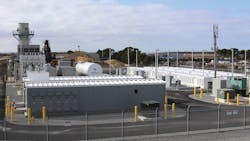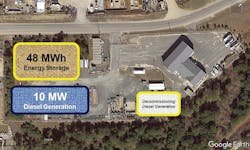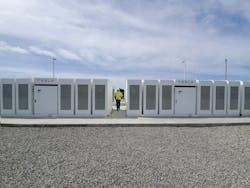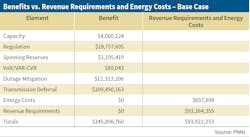Advanced Use Cases of Batteries on Nantucket
The decarbonization of the energy system is one of the biggest challenges facing the world today, and electric utilities have critical role to play in the acceleration toward a cleaner future. National Grid plc, which supplies energy to more than 20 million people, recently announced a new net-zero target to reduce its direct greenhouse gas emissions by 2050. This entails reducing greenhouse gas emissions in generation, transportation and heat while integrating more renewable distributed energy resources (DERs), which heavily contribute to the reduction of greenhouse gas emissions in the generation sector.
Traditionally, the electric power system was designed to deliver power from wholesale power plants to transmission and then to consumers on the distribution network. With the high penetration of DERs, the direction of power flow is changing. This change poses challenges to system protection, operation, power quality and more. Utilities are resolving these challenges by upgrading the electric power system, including the installation of 3V0 (59N) relays on ungrounded systems, load-tap changer controller upgrades, feeder voltage-regulator upgrades, energy storage and more.
Among these potential system upgrades, in addition to mitigating power-quality issues, energy storage provides a wide range of significant advantages. Storage stands to create benefits that include enhanced system reliability, resiliency, peak shaving, phase balancing, line and substation upgrade deferrals, frequency regulation, frequency response, spin/non-spin reserve and ramping reserve. As part of its strategy to decarbonize the energy system and enhance resiliency, National Grid is actively pursuing energy storage on its network to cost effectively resolve T&D needs and provide network reliability benefits. The utility has many energy storage initiatives in operation and development, including its Nantucket Island battery energy storage system (BESS).
Nantucket’s Needs
Located about 30 miles (48 km) off the southern coast of Cape Cod, Massachusetts, U.S., Nantucket Island is best known as a popular summer tourist destination. During the months of April through October, the island’s population roughly quintuples, amassing a unique peak demand for power.
Until the 1990s, the island generated its own power by steam engines and then by diesel generators. When increasing demand outpaced the plant’s generating capacity, National Grid opted to install two undersea high-voltage cables, one in 1996 and another in 2005, which provide an additional capacity of around 74 MW.
In 2013, demand for energy in Nantucket grew an astounding 13% over the prior year to 44.7 MW, following a five-year average load growth of 4% between 2008-2013. This was significantly higher than the load growth for all of Massachusetts in the same time period, which was 0.6%.
To plan for future needs, National Grid conducted an analysis of future growth in demand through 2024, using the 2013 summer peak loads and the 2014 New England electric peak forecast, released in November 2013.
A Battery-Plus Solution
To control for a potential outage if one of the undersea cables were to fail during peak load, National Grid developed an integrated plan, called IslandReady, to upgrade Nantucket’s electricity infrastructure. Among the options the utility evaluated to manage the risk were a third undersea cable, a stand-alone large gas-combustion generation facility, a stand-alone large battery and a hybrid battery-plus-gas-combustion generation option.
National Grid ruled out the third undersea cable option in the near term because of the complexity and cost, while the stand-alone gas-combustion generation facility was not a good option from an environmental perspective. In addition, the stand-alone storage option was too expensive to install.
Therefore, National Grid opted for a hybrid approach, installing a 6-MW Li-ion battery manufactured by Tesla and a 10-MW combustion turbine generator sited on the island. This solution enabled the utility to defer construction of a third underground cable until 2045. It also gave the utility an opportunity to explore use cases for DER with support from a storage resource.
National Grid completed construction and commissioned the 6-MW/48-MWh Nantucket BESS in October 2019.
“Both energy storage and a backup generator are vital components to ensuring resilience and reliability on Nantucket during the busiest summer months,” said Rudy Wynter, president and COO of National Grid’s wholesale networks and U.S. capital delivery group, in a National Grid press release. “Battery storage is key to unlocking the state’s and the island’s clean energy future.”
The battery storage and diesel generator sizes were selected to ensure 100% reliability during the peak-load summer months. In addition, National Grid is investigating ISO New England’s wholesale market participation opportunities.
Benefits of Energy Storage
The Nantucket BESS is one of 13 National Grid energy storage projects located in New York and Massachusetts. The utility is working with the Pacific Northwest National Laboratory (PNNL) to evaluate the full range of technical benefits and wholesale market participation opportunities the Nantucket storage system can provide. In terms of market benefits, the study shows that there are estimated to be $24 million of lifetime benefits from providing market services. The full results of the PNNL study were published in August of 2019 on the PNNL.
National Grid has studied the reliability of its transmission system and concluded energy storage can be used to cost effectively address transmission needs in specific circumstances. More generally, National Grid has found energy storage can offer a variety of benefits and challenges. The IEEE 1547-2018 Energy Storage Grid Support Services standard lists benefits such as voltage regulation (where an inverter is used to regulate the system voltage), ride through (where an inverter can support bulk system disturbances) and the potential formation of microgrids.
With respect to benefits, the National Grid is looking at how individual storage units or storage units in conjunction with power-flow controller devices may be the least-cost solution to address case-specific reliability issues on the transmission network. In a joint effort, National Grid and Quanta Technology LLC developed a storage benefit cost-analysis tool to determine which energy storage solutions are cost efficient compared to traditional solutions, like line and transformer upgrades. This tool can be customized based on different market and policy conditions.
In addition, the utility is investigating how BESS can provide power-quality grid support services such as volt/reactive volt-ampere (volt/VAR) and frequency-watt support. The inverters used to connect the direct-current (dc) battery system to the alternating-current (ac) electric grid can support the grid by regulating the system voltage, responding to and regulating the system frequency changes, forming an island system to enhance resiliency and providing communication the utility can use for dispatch. It also can support the bulk power system’s stability by using the ride-through capability.
Moving Forward
The Nantucket BESS will ensure electric reliability for customers during peak summer months and defer the need for construction of an additional underwater supply cable to the island. The utility benefited by not only installing this BESS but also taking the opportunity to study the use cases of energy storage in detail.
Based on its studies, National Grid has found energy storage can offer a variety of benefits and challenges. With respect to benefits, an energy storage resource — either by itself or in conjunction with power-flow controller devices — may be the least-cost solution to address case-specific reliability issues on the transmission network. A BESS also can provide power-quality grid support services, like volt/VAR and frequency-watt.
With respect to challenges, the first one centers on cybersecurity. Specifically, cybersecurity with the energy management system (EMS) can be problematic as some energy storage inverters are manufactured outside the U.S. Cybersecurity standards need to be updated frequently to maintain the resiliency of the electric grid.
A second challenge is some regional planning processes by regional transmission organizations and independent system operators do not consider energy storage as a potential solution to meet reliability needs.
Furthermore, because of the variety of storage inverter designs and proprietary information protected by manufacturers, a third challenge is the lack of standard storage models. This poses a challenge to utilities when trying to properly model energy storage in their planning studies.
All in all, considering both the benefits and the challenges, National Grid believes utilities should be allowed to own energy storage where there are reliability needs, and they should be able to participate in the wholesale market.
As stated by former MA Department of Energy Resources Commissioner Judith Judson in a National Grid press release, “Energy storage projects like National Grid’s battery energy storage system are a critical part of unlocking the full potential of clean energy and increasing the resiliency of the electrical grid.”
Dr. Babak Enayati ([email protected]) joined National Grid plc in 2009 and is currently manager of the engineering and technology deployment team, which is charged with the development and implementation of the transmission network modernization strategy. His past responsibilities included distributed energy resource interconnections, power system protection, control of microgrids and smart grids. He also serves as vice chair of the IEEE Standards Coordinating Committee 21 and IEEE 1547 Interconnecting Distributed Energy Resources with Electric Power Systems standard. He is a registered professional engineer (PE) in the state of Massachusetts.
John Skrzypczak began his career at National Grid in 2002 in the Distribution Engineering department. He later became the supervisor for the group and joined the Complex Project Management team in 2013. He is a graduate of Worcester Polytechnic Institute with a BSEE, MSEE, and MBA, and is PMP certified.
For more information:
PNNL | www.pnnl.gov
Quanta Technology | https://quanta-technology.com
Tesla | www.tesla.com
About the Author
Babak Enayati
Dr. Babak Enayati joined National Grid, Waltham, Massachusetts, in 2010 and is currently the manager of the technology deployment team, which is charged with the development and implementation of the transmission network modernization strategy. His responsibilities also include DER interconnections, power system protection, control of microgrids, and smart grids. He also serves as the vice chair of the IEEE Standards Coordinating Committee 21 (SCC21) and IEEE 1547, Standard for Interconnecting Distributed Energy Resources with Electric Power Systems. He is a registered professional engineer (PE) in the state of Massachusetts.





